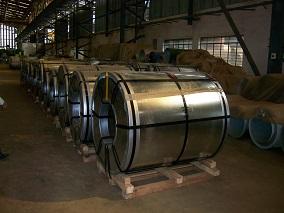President/CEO
- FMA
- The Fabricator
- FABTECH
- Canadian Metalworking
Categories
- Additive Manufacturing
- Aluminum Welding
- Arc Welding
- Assembly and Joining
- Automation and Robotics
- Bending and Forming
- Consumables
- Cutting and Weld Prep
- Electric Vehicles
- En Español
- Finishing
- Hydroforming
- Laser Cutting
- Laser Welding
- Machining
- Manufacturing Software
- Materials Handling
- Metals/Materials
- Oxyfuel Cutting
- Plasma Cutting
- Power Tools
- Punching and Other Holemaking
- Roll Forming
- Safety
- Sawing
- Shearing
- Shop Management
- Testing and Measuring
- Tube and Pipe Fabrication
- Tube and Pipe Production
- Waterjet Cutting
Industry Directory
Webcasts
Podcasts
FAB 40
Advertise
Subscribe
Account Login
Search
Steel buyers facing a triple whammy?
Steel mills call for price increases, while federal government could crack down on imports and tighten trade laws
- By John Packard
- June 27, 2017
- Article
- Shop Management

A crackdown on steel imports not only affects steel consumers, such as metal fabricators, but also the port personnel and logistics companies that move the material to where it’s needed.
The steel industry has a way of surprising those who use its products. This may be especially true this year as it appears the industry is about to enter a phase not seen in decades.
As of mid-June, the domestic flat-rolled steel mills are raising prices as the U.S. Department of Commerce (DOC) is about to release its Section 232 recommendations on steel to President Trump. (Section 232 of the Trade Expansion Act of 1962 authorizes the secretary of commerce to investigate the effects of imports, in this case steel, and how they might affect the overall security of the U.S.) The industry is bracing for big changes.
The steel mills seem to have discovered newfound courage with the expectation of less competition from foreign steel. They expect Trump to announce a variety of remedies to address the amount of imports coming into the U.S. in an attempt to strengthen the domestic steelmaking base and bolster national security.
During the week of June 5, every major U.S. and Canadian flat-rolled sheet mill announced $30/ton ($1.50/cwt) increases. Benchmark hot-rolled pricing is now approaching $600/ton after declining to an average of $580/ton (with the low end of the range dropping to the $540-$560 area), according to the Steel Market Update index.
The price announcements and the resulting surge of orders from service centers and end users are pushing lead times out anywhere from one to four weeks, depending on product, producer, and location. As lead times extend, this creates a situation that emboldens the North American steel mills.
Rumors are flying that the sheet mills were going to announce another price increase yet again later in June. It appears the steel mills want to get as many price announcements into the system as possible prior to the president’s Section 232 decision.
After Trump makes his announcement, well, all heck is expected to break loose. Many in the industry see Section 232 restrictions on imports as a foregone conclusion.
Is the Industry Approaching Allocations?
“Two mills told me today that once 232 is announced and the flurry of new orders rushes in, they will vow to ‘protect’ their current and loyal customers and not bump them out in favor of new customers willing to pay higher spot pricing,” said the vice president of a large U.S.-based service center. “I find this disturbing, as 232 is yet to be announced, and the mills are already talking allocation language. Almost like the mills were ‘tipped off’ on what is coming?”
Allocation is a bad word if your company is a buyer of steel. You may not be able to get all the material you need. Steel buyers are also potentially in jeopardy whenever the U.S. government gets involved with picking winners and losers.
The rumor mill is also churning on what form the sanctions against imports may take, ranging anywhere from a 30 percent tariff to a trade rate quota (TRQ) system. SMU’s prediction is that Commerce Secretary Wilbur Ross will recommend a formula for determining the “normal” level of imports, and then somehow put a collar around that average and subject imports that exceed it to a very high tariff.
Picking the appropriate time period for the TRQ formula will also be politically and emotionally charged. If the time period is a five-year average with the suggestion being prior to the surge in imports in 2014-2015, then we may be looking at the years 2009-2013. You don’t have to be a rocket scientist to remember that 2009-2010 were two of the worst years for the steel industry, both domestically and internationally, due to the Great Recession.
Many in the industry believe restricting foreign steel is a bad idea, including manufacturers that rely on foreign steel, ports that handle foreign steel, logistics and trading companies that support foreign steel, and even certain segments of the government.
In a World Trade Online article published June 12, some key players questioned Section 232, including Treasury Secretary Steven Mnuchin, National Economic Council Director Gary Cohn, and the Department of Defense itself—which is ironic since a Section 232 investigation is based on “national security.”
Press Secretary Sean Spicer told reporters on June 12 that the report from the DOC also will recommend that Congress take action. According to World Trade Online, Spicer said, “When that comes out, there are certain recommendations that will be made to Congress to address antidumping provisions in the steel and aluminum and other markets. I think there will be recommendations to Congress to follow up on how to rectify some of the problems.”
That makes it a triple whammy for those wanting to buy the most competitively priced steel for their company. First, the U.S. and Canadian steel mills are pushing prices higher. Second, we have the expectation of a Section 232 announcement, which will stem the excessive flow of imports. And third, we have the DOC’s recommendation to Congress to tighten trade laws to benefit the steel industry.
Steel buyers should also be aware that the one-year review of the antidumping (AD) and countervailing duty (CVD) trade cases on corrosion-resistant, cold-rolled, and hot-rolled steel will begin this summer.
It’s an interesting and exciting time to be involved with the steel industry.
To stay updated on this issue and others affecting steel purchasing, consider attending the Steel Market Update’s seventh SMU Steel Summit Conference on Aug. 28-30 in Atlanta. We will have speakers discussing trade-related topics, including the debate over free and fair trade, Section 232, Section 337, circumvention, and the status of the AD/CVD trade suits. We will have speakers forecasting commodity and steel prices through 2018 and general economic conditions for the near term. Attendees also can expect many other topics associated with manufacturing and steel.
You can find details about our conference at www.steelmarketupdate.com/events/steel-summit, or contact me at john@steelmarketupdate.com.
About the Author

John Packard
800-432-3475
John Packard is the founder and publisher of Steel Market Update, a steel industry newsletter and website dedicated to the flat-rolled steel industry in North America. He spent the first 31 years of his career selling flat-rolled steel products to the manufacturing and distribution communities.
subscribe now

The Fabricator is North America's leading magazine for the metal forming and fabricating industry. The magazine delivers the news, technical articles, and case histories that enable fabricators to do their jobs more efficiently. The Fabricator has served the industry since 1970.
start your free subscription- Stay connected from anywhere

Easily access valuable industry resources now with full access to the digital edition of The Fabricator.

Easily access valuable industry resources now with full access to the digital edition of The Welder.

Easily access valuable industry resources now with full access to the digital edition of The Tube and Pipe Journal.
- Podcasting
- Podcast:
- The Fabricator Podcast
- Published:
- 04/16/2024
- Running Time:
- 63:29
In this episode of The Fabricator Podcast, Caleb Chamberlain, co-founder and CEO of OSH Cut, discusses his company’s...
- Trending Articles
Tips for creating sheet metal tubes with perforations

Supporting the metal fabricating industry through FMA

JM Steel triples capacity for solar energy projects at Pennsylvania facility

Are two heads better than one in fiber laser cutting?

Fabricating favorite childhood memories

- Industry Events
16th Annual Safety Conference
- April 30 - May 1, 2024
- Elgin,
Pipe and Tube Conference
- May 21 - 22, 2024
- Omaha, NE
World-Class Roll Forming Workshop
- June 5 - 6, 2024
- Louisville, KY
Advanced Laser Application Workshop
- June 25 - 27, 2024
- Novi, MI


























